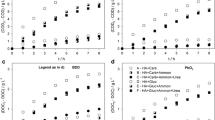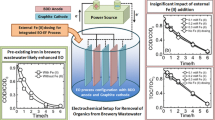Abstract
This paper compares the performance of 2D (plate) and 3D (mesh) boron-doped diamond (BDD) electrodes, fitted into a filter-press reactor, during the electrochemical incineration of indigo textile dye as a model organic compound in chloride medium. The electrolyses were carried out in the FM01-LC reactor at mean fluid velocities between 0.9 ≤ u ≤ 10.4 and 1.2 ≤ u ≤ 13.9 cm s−1 for the 2D BDD and the 3D BDD electrodes, respectively, at current densities of 5.63 and 15 mA cm−2. The oxidation of the organic matter was promoted, on the one hand, via the physisorbed hydroxyl radicals (BDD(●OH)) formed from water oxidation at the BDD surface and, on the other hand, via active chlorine formed from the oxidation of chloride ions on BDD. The performance of 2D BDD and 3D BDD electrodes in terms of current efficiency, energy consumption, and charge passage during the treatments is discussed.







Similar content being viewed by others
References
Andrade LS, Tasso TT, Da Silva D (2009) On the performances of lead dioxide and boron-doped diamond electrodes in the anodic oxidation of simulated wastewater containing the Reactive Orange 16 dye. Electrochim Acta 54(7):2024–2030
Anglada A, Urtiaga A, Ortiz I (2009) Pilot scale performance of the electro-oxidation of landfill leachate at boron-doped diamond anodes. Environ Sci Technol 43(6):2035–2040
APHA, AWWA, WPCF (1995) Standard methods for the examination of water and wastewater, New York
Brillas E, Sirés I, Oturan MA (2009) Electro-Fenton process and related electrochemical technologies based on Fenton’s reaction chemistry. Chem Rev 109(12):6570–6631
Brown CJ, Pletcher D, Walsh FC (1992) Local mass transport effects in the FM01 laboratory electrolyser. J Appl Electrochem 22(7):613–619
Butrón E, Juárez ME, Solis M, Teutli M, González I, Nava JL (2007) Electrochemical incineration of indigo textile dye in filter-press-type FM01-LC electrochemical cell using BDD electrodes. Electrochim Acta 52(24):6888–6894
Chen X, Gao F, Chen G (2005) Comparison of Ti/BDD and Ti/SnO2–Sb2O5 electrodes for pollutant oxidation. J Appl Electrochem 35(2):185–191
Comninellis C (1994) Electrocatalysis in the electrochemical conversion/combustion of organic pollutants for waste water treatment. Electrochim Acta 39(11–12):1857–1862
Doǧan D, Türkdemir H (2005) Electrochemical oxidation of textile dye indigo. J Chem Technol Biotechnol 80(8):916–923
Faouzi M, Cañizares P, Gadri A (2006) Advanced oxidation processes for the treatment of wastes polluted with azoic dyes. Electrochim Acta 52(1):325–331
Faouzi AM, Nasr B, Abdellatif G (2007) Electrochemical degradation of an anthraquinone dye Alizarin Red S by oxidation on boron-doped diamond. Dyes Pigments 73(1):86–89
Martínez-Huitle CA, Brillas E (2009) Decontamination of wastewaters containing synthetic organic dyes by electrochemical methods: a general review. Appl Catal B Environ 87(3–4):105–145
Nava JL, Núñez F, González I (2007) Electrochemical incineration of o-cresol and p-cresol in the filter-press-type FM01-LC electrochemical cell using BDD electrodes in sulphate media at pH 0. Electrochim Acta 52(9):3229–3235
Nava JL, Quiroz MA, Martínez-Huitle CA (2008a) Electrochemical treatment of synthetic wastewaters containing Alphazurine A dye: role of electrode material in the colour and COD removal. J Mex Chem Soc 52(4):249–255
Nava JL, Recéndiz A, Acosta JC, González I (2008b) Electrochemical incineration of vinasse in filter-press-type FM01-LC reactor using BDD electrodes. Water Sci Technol 58(12):2413–2419
Oliveira FH, Osigi ME, Paschoal FMM (2007) Electrochemical oxidation of an acid dye by active chlorine generated using Ti/Sn(1−x)IrxO2 electrodes. J Appl Electrochem 37(5):583–592
Panakoulias T, Kalatzis P, Kalderis D (2010) Electrochemical degradation of Reactive Red. J Appl Electrochem 40(10):1759–1765
Panizza M, Cerisola G (2008a) Electrochemical degradation of methyl red using BDD and PbO2 anodes. Ind Eng Chem Res 47(8):6816–6820
Panizza M, Cerisola G (2008b) Removal of colour and COD from wastewater containing acid blue 22 by electrochemical oxidation. J Hazard Mater 153(1–2):83–88
Panizza M, Kapalka A, Comninellis C (2008) Oxidation of organic pollutants on BDD anodes using modulated current electrolysis. Electrochim Acta 53(5):2289–2295
Polcaro AM, Mascia M, Palmas S (2004) Electrochemical degradation of diuron and dichloroaniline at BDD electrode. Electrochim Acta 49(4):649–656
Rajkumar D, Song BJ, Kim JG (2007) Electrochemical degradation of Reactive Blue 19 in chloride medium for the treatment of textile dyeing wastewater with identification of intermediate compounds. Dyes Pigments 72(1):1–7
Rangel M, Nava JL, Peralta-Hernández JM, Carreño G, Guerra-Sánchez RJ (2013) Electrochemical oxidation of Reactive Blue 222 on boron-doped diamond electrodes. Int J Electrochem Sci 8:3310–3320
Rodríguez J, Rodrigo MA, Panizza M, Cerisola G (2009) Electrochemical oxidation of Acid Yellow 1 using diamond anode. J Appl Electrochem 39(11):2285–2289
Salazar R, Brillas E, Sirés I (2012) Finding the best Fe2+/Cu2+ combination for the solar photoelectro-Fenton treatment of simulated wastewater containing the industrial textile dye Disperse Blue 3. Appl Catal B Environ 115–116:107–116
Salazar C, Sirés I, Zaror CA, Brillas E (2013) Treatment of a mixture of chloromethoxyphenols in hypochlorite medium by electrochemical AOPs as an alternative for the remediation of pulp and paper mill process waters. Electrocatalysis 4(4):212–223
Sirés I, Brillas E (2012) Remediation of water pollution caused by pharmaceutical residues based on electrochemical separation and degradation technologies: a review. Environ Int 40:212–229
Yavuz Y, Koparal AS, Ögütveren UB (2008) Phenol degradation in a bipolar trickle tower reactor using boron-doped diamond electrode. J Environ Eng 134(1):24–31
Acknowledgments
J.L. Nava is grateful to CONACYT and CONCYTEG for the economic support via the project FOMIX GTO-2012-C04-195057. J.L. Nava thanks funding from the University of Guanajuato. I. Sirés and E. Brillas are grateful to MICINN (Ministerio de Ciencia e Innovación, Spain) for financial support under project CTQ2010-16164/BQU, cofinanced with FEDER funds.
Author information
Authors and Affiliations
Corresponding author
Additional information
Responsible editor: Philippe Garrigues
Rights and permissions
About this article
Cite this article
Nava, J.L., Sirés, I. & Brillas, E. Electrochemical incineration of indigo. A comparative study between 2D (plate) and 3D (mesh) BDD anodes fitted into a filter-press reactor. Environ Sci Pollut Res 21, 8485–8492 (2014). https://doi.org/10.1007/s11356-014-2781-3
Received:
Accepted:
Published:
Issue Date:
DOI: https://doi.org/10.1007/s11356-014-2781-3




